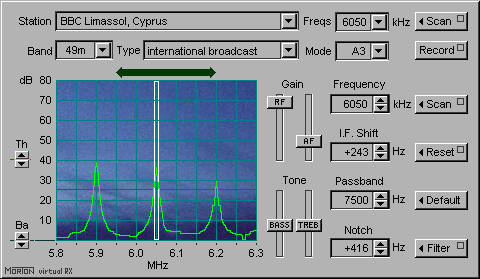
Ch06: Footnotes
Critical Mass
DSS Savings Limit
Market Exclusion
Cost of Marketing
Acquisition
Social Isolation
Blaming Society
Nebulous Money
Social Isolation
Free Competition
The short wave bands are a cacophony of competing signals from all over the world. But only the powerful stations of the rich nations can be heard above the noise. So it is in the world of commerce. Only the corporate elite can afford to make their voices heard above the mêlée of the free market.
Below is a view of the control panel for a modern radio receiver. It is displayed on the screen of a personal computer as shown. It is used to control radio receiver hardware which is connected to the computer via an interface cable.

The coloured area shows a spectrum analysis of a section of the short wave known as the 49 metre band. It is used for international broadcasts. The night sky background indicates that this is a band which is mainly active at night. The green trace shows the power of the radio signals being received at the different frequencies across the band. The white rectangle defines the narrow pass-band over which the receiver is actually 'listening' at any given time.
The band is packed with signals. However, only 3 very powerful ones dominate. The 'Ba' buttons are used to shift the trace vertically so that the ambient signal level across the band as a whole is at the bottom of the little 'screen'. The 'Th' buttons are then used to adjust the height of the red line. This determines the power level below which signals will not be heard. It is called the squelch threshold. The current position of the red line ensures that, as you sweep across the band, only the 3 dominant stations will actually be heard. All in between them will be silence.
This highly sensitive and precisely selective receiver is a far cry from the one which I built when I was 14. That was a very simple one. It was a type known as a Tuned Radio Frequency [TRF] receiver. The trouble with a TRF is that, unlike the now universal superhet, it was not very selective. It tended to pick up signals over a broad portion of the radio band centred around the frequency to which it was supposed to be tuned.
The result was that the station it was tuned to was often interfered with by other stations on adjacent frequencies. To my TRF receiver, the radio band was a mad cacophony of stations, each one trying to make itself heard above the rest. Listening to it was rather like being in a crowded restaurant with its constant background chatter. Suddenly, I would tune across a powerful station. This was like hearing a plummy-throated goyt on a distant table start to pontificate about pointless trivia as if he were addressing the House of Commons against Opposition jeers. So although the short wave broadcast bands are populated with thousands of signals from all over the world, they are completely dominated by a forceful few. Theirs are the only signals which generally get heard.
Less than 100 years ago, when radio communication was in its infancy, there were no restrictions on its use. One could experiment to one's heart's content. The powers that be did not yet understand its potential. But as soon as they did, in came the restrictions as to how radio communications could be used, and by whom. Of course, there have to be rules. If there were no rules as to who should and who should not use each part of each band and when, then chaos would reign. That is simply a matter of organising.
Internationally, nations subscribe to broadcasting conventions which they obey when it suits them and break when it does not. This means that between nations, short wave broadcasting has become a free-for-all. The only nations who can be heard are those who can afford to build the most powerful transmitters. However, this is a game which only nations can play. There is no global authority to enforce international conventions. Hence the cacophony, above which he who is loudest is he who is heard.
International conventions are one thing. Restrictions are something different. Internally, each nation imposes restrictions on its own subjects through law. Consequently, no ordinary person is allowed to broadcast over the radio — except by the leave of those who control his nation's broadcasting media. Hence he can never discuss a subject or express an opinion about anything which does not have official approval. Commercial organisations and public services are allowed to use radio communications where they can demonstrate an approved need. But these are restricted by law to low power, short range, and narrowly specified message content.
Surprisingly, amateur radio enthusiasts have more latitude. They can use more power, although it is still very low compared with national broadcasts. They can communicate world wide but they are severely restricted in band space. However, their main and most frustrating restriction is with regard to content. There are Draconian restrictions regarding what they can and cannot say over the radio. They must not mention anything which could be construed as in any way:
This certainly rules out discussions on socio-economics. Debates about philosophy could easily invade the realm of politics. One even wonders if an erudite discussion on fundamental physics could encroach into the politics of research funding. This leaves only two subjects which may be discussed with reasonable safety, namely:
The radio amateur is thus effectively gagged. Such restrictions trivialise short wave radio as a direct means for the individual to make his voice heard and to exchange views with his friends across the world.
Consequently, from his suburban isolation, the individual can access the public ear only through regulated media. Furthermore, he will be granted such access only on condition that what he has to say is approved of by those who regulate the media. In any case, regulated media have a very limited bandwidth. They are able to carry the voices of only a very few. In short, they provide a channel of free speech only to a favoured few whose opinions happen to fit the official mould, and whose names happen to be drawn out of the producer's hat.
We still have the Internet. However, ominous murmurs of regulation and censorship are rising under the false banner of public interest. Let us hope that providence will grant us our say before the iron curtains finally close upon this last open stage of free speech.
The spectrum pattern of the 49 metre band, as displayed by the control panel above, and as heard through the loudspeaker of my old TRF receiver, is I think an excellent and tangible analogy of the capitalist free market as it impinges upon the individual. He is continually bombarded with a cacophony of advertising signals from the mass media cajoling him into buying this product or that service. However, the only signals which are able successfully to force themselves upon his attention are those from the corporate powerhouses — the mighty 'household names'. Like the 3 dominant signals shown in the spectrum pattern above, they are the only ones to be heard clearly above the mêleé.
The receiver — the consumer's mind — has its own 'Ba' control with which it adjusts its threshold of commercial perception. It also has its own 'Th' control with which it sets the power threshold at which an advertising activity is able to capture his attention. It seems that our minds automatically raise our attention thresholds (or market resistance) to keep the number of commercial signals we 'hear' down to a number we can handle. This number is a natural constant of the human mind. No matter how powerful, how novel or how expensive commercial advertising may become, that number of dominant signals cannot be exceeded. It seems that we only have that certain number of pigeon holes in which we can accommodate our commercial 'household names'.
Nevertheless, unbridled competition drives the corporates to push the levels of their advertising signals higher and higher. This in turn forces the consumer to raise his threshold of market resistance. The corporates then answer by increasing the power of their advertising even more. A spiralling positive feed-back loop is thus established which drives advertising signal power higher and higher to an ultimate crescendo which only the largest corporates have the resources to sustain. The result is that the only signals coming in from the market, of which the potential buyer is aware, are those from the corporate giants.
The corporate vendor is far too large and faceless to be able to gain the trust of its vast market by establishing a personal rapport with each one of its multitude of customers. It must use mass-media advertising. This delivers a message which is loud and simple. It portrays the corporate advertiser as friendly, trustworthy, reliable and permanent. The message is specially engineered to set the consumer at ease with the thought of buying from that particular source. The consumer thus comes to 'know' and trust it.
This consumer trust is not built on anything tangible. It is built purely on image. It is built on make-believe. The consumer does not have to know how well the vendor's product or service can help him in relation to his specific needs. He simply has to have heard of the vendor's name within a favourable context. He has merely to have heard others say that they have heard of it. Everybody's talking about its products. They incorporate the latest technology. They are the fashion of the moment.
Corporate advertising has one collective effect. It causes one's notions of friendliness, trustworthiness, reliability and permanence to become synonymous with corporate size. This association thus becomes unshakeably fixed within the public mind. As a direct consequence, the small, low-profiled, invisible and unheard-of artisan becomes undeservedly branded as being unfriendly, unreliable, untrustworthy and fleeting. A notion which has no factual basis.
It is against this invincible cacophony of corporate advertising that the lone artisan must struggle to carve and protect his market niche. But times have changed. Long gone are the days when one could start small and build up. I was starting small for 15 years, trapped in an eternal chicken and egg scenario. To get anywhere in today's market, one must enter it with the instant impact of a totally dominating presence which matches that of the large corporate players. This demands heavy financing not available to the lone artisan.
Yet the lone artisan is the ultimate hive of innovation. When compelled to go a mile, he will gladly go two. His reward is to see the fruit of his labour making his client's life that much easier. But his works cannot save him. He cannot afford the accelerating cost of keeping his voice heard above the rising crescendo of corporate advertising. Like the lesser stations of the 49 metre band he sinks helplessly below the dispassionate ambience.
His towering corporate competitors watch and wait. They stand poised to strike in his moment of weakness. Then, as his business falters they add his little clutch of clients to their legions and him to their captive staff of slaves. He is now locked out of the so-called free market forever. He can no longer ply his hard earned skills except by the leave of his new corporate masters.